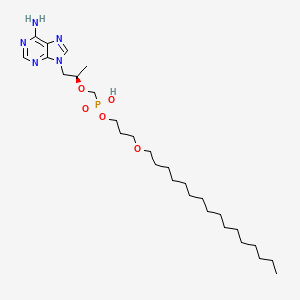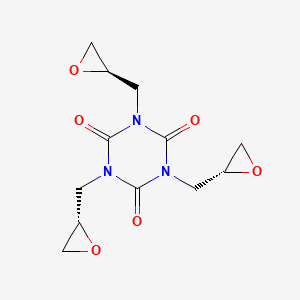
トルブタミド
概要
説明
トルブタミドは、主に2型糖尿病の治療に使用される第一世代のスルホニルウレア系の経口血糖降下薬です。 1956年に発見され、膵臓からのインスリン分泌を促進することで血糖値を下げる働きがあります . トルブタミドは有効性がある一方で、副作用が少なく、より新しい第二世代のスルホニルウレア系薬剤が利用可能になったため、現在では日常的に使用されていません .
2. 製法
合成経路と反応条件: トルブタミドは、トリエチルアミンとテトラヒドロフランの存在下で、p-トルエンスルホンアミドとブチルイソシアネートを反応させることで合成できます . 別の方法としては、特定のカルバメート誘導体を熱トルエンに溶解し、ブチルアミンをゆっくりと添加し、4時間還流する方法があります .
工業的生産方法: 工業的な設定では、トルブタミド粒子は、バルク薬剤と超臨界流体を混合して超臨界混合物を形成し、その後膨張させてトルブタミド粒子を得ることで調製できます . この方法は、特にトルブタミドの微粒子を製造するのに役立ちます。
3. 化学反応解析
反応の種類: トルブタミドは、酸化、還元、置換反応など、さまざまな化学反応を起こします。
一般的な試薬と条件:
酸化: トルブタミドは、強力な酸化剤を使用して酸化できます。
還元: 還元反応は、通常、水素化リチウムアルミニウムなどの還元剤を用いて行われます。
置換: 置換反応は、適切な条件下で求核剤または求電子剤の存在下で起こります。
主な生成物: これらの反応から生成される主な生成物は、使用される特定の試薬と条件によって異なります。たとえば、酸化はスルホン酸誘導体を生成する可能性があり、還元はアミン誘導体を生成する可能性があります。
作用機序
トルブタミドは、膵臓のβ細胞からインスリンの放出を促進することで、血糖降下作用を発揮します。 β細胞のATP感受性カリウムチャネルに結合して阻害することで、細胞の脱分極を引き起こし、その後のインスリン放出につながります . さらに、トルブタミドは肝臓からのグルコース産出を抑制し、末梢標的部位におけるインスリン感受性を高めます .
科学的研究の応用
トルブタミドは、科学研究において幅広い応用範囲を持っています。
生化学分析
Biochemical Properties
Tolbutamide interacts with the sulfonylurea receptor (SUR1) on the pancreatic β cells. This interaction stimulates the release of insulin, increasing both basal insulin secretion and meal-stimulated insulin release . It also increases peripheral glucose utilization, decreases hepatic gluconeogenesis, and may increase the number and sensitivity of insulin receptors .
Cellular Effects
Tolbutamide influences cell function by stimulating the acute release of insulin from functioning beta cells of pancreatic islet tissue . This leads to an increase in peripheral glucose utilization and a decrease in hepatic gluconeogenesis .
Molecular Mechanism
Tolbutamide exerts its effects at the molecular level by binding to the sulfonylurea receptor on the beta cell, stimulating the acute release of insulin . This process involves the inhibition of ATP-sensitive potassium channels on the beta cell membrane, leading to depolarization and calcium influx, which triggers insulin release .
Temporal Effects in Laboratory Settings
The effects of Tolbutamide have been observed to change over time in laboratory settings. For instance, the binding of Tolbutamide to albumin in subdomain IIA and/or IIIA as well as in subdomains IB and IIB influences its therapeutic effect .
Metabolic Pathways
Tolbutamide is metabolized in the liver, primarily via oxidation of the p-methyl group, producing the carboxyl metabolite, 1-butyl-3-p-carboxyphenylsulfonylurea . It may also be metabolized to hydroxytolbutamide .
Transport and Distribution
Tolbutamide is transported from the brain to the blood via a non-P-glycoprotein efflux transport system, which is inhibited by sulphonamides . It is detectable in plasma 30-60 minutes following oral administration, with peak plasma concentrations occurring within 3-5 hours .
準備方法
Synthetic Routes and Reaction Conditions: Tolbutamide can be synthesized through the reaction of p-toluene sulfonamide with butyl isocyanate in the presence of triethylamine and tetrahydrofuran . Another method involves dissolving a specified carbamate derivative in hot toluene, adding butylamine slowly, and refluxing for four hours .
Industrial Production Methods: In industrial settings, tolbutamide particles can be prepared by mixing the bulk drug with a supercritical fluid to form a supercritical mixture, which is then expanded to obtain the tolbutamide particles . This method is particularly useful for producing tolbutamide micro-particles.
化学反応の分析
Types of Reactions: Tolbutamide undergoes various chemical reactions, including oxidation, reduction, and substitution reactions.
Common Reagents and Conditions:
Oxidation: Tolbutamide can be oxidized using strong oxidizing agents.
Reduction: Reduction reactions typically involve the use of reducing agents like lithium aluminum hydride.
Substitution: Substitution reactions can occur in the presence of nucleophiles or electrophiles under appropriate conditions.
Major Products: The major products formed from these reactions depend on the specific reagents and conditions used. For example, oxidation may yield sulfonic acid derivatives, while reduction could produce amine derivatives.
類似化合物との比較
トルブタミドは、アセトヘキサミド、クロルプロパミド、トラザミドなどの他の化合物を含む、スルホニルウレア系のインスリン分泌促進剤に属します . これらの化合物と比較して、トルブタミドは作用時間が短く、副作用の発生率が高いです . トルブタミドは、作用発現が速く、インスリン放出を促進する効果が高いため、糖尿病管理において依然として貴重なツールです。
類似化合物:
- アセトヘキサミド
- クロルプロパミド
- トラザミド
特性
IUPAC Name |
1-butyl-3-(4-methylphenyl)sulfonylurea | |
|---|---|---|
| Source | PubChem | |
| URL | https://pubchem.ncbi.nlm.nih.gov | |
| Description | Data deposited in or computed by PubChem | |
InChI |
InChI=1S/C12H18N2O3S/c1-3-4-9-13-12(15)14-18(16,17)11-7-5-10(2)6-8-11/h5-8H,3-4,9H2,1-2H3,(H2,13,14,15) | |
| Source | PubChem | |
| URL | https://pubchem.ncbi.nlm.nih.gov | |
| Description | Data deposited in or computed by PubChem | |
InChI Key |
JLRGJRBPOGGCBT-UHFFFAOYSA-N | |
| Source | PubChem | |
| URL | https://pubchem.ncbi.nlm.nih.gov | |
| Description | Data deposited in or computed by PubChem | |
Canonical SMILES |
CCCCNC(=O)NS(=O)(=O)C1=CC=C(C=C1)C | |
| Source | PubChem | |
| URL | https://pubchem.ncbi.nlm.nih.gov | |
| Description | Data deposited in or computed by PubChem | |
Molecular Formula |
C12H18N2O3S | |
| Record name | TOLBUTAMIDE | |
| Source | CAMEO Chemicals | |
| URL | https://cameochemicals.noaa.gov/chemical/21120 | |
| Description | CAMEO Chemicals is a chemical database designed for people who are involved in hazardous material incident response and planning. CAMEO Chemicals contains a library with thousands of datasheets containing response-related information and recommendations for hazardous materials that are commonly transported, used, or stored in the United States. CAMEO Chemicals was developed by the National Oceanic and Atmospheric Administration's Office of Response and Restoration in partnership with the Environmental Protection Agency's Office of Emergency Management. | |
| Explanation | CAMEO Chemicals and all other CAMEO products are available at no charge to those organizations and individuals (recipients) responsible for the safe handling of chemicals. However, some of the chemical data itself is subject to the copyright restrictions of the companies or organizations that provided the data. | |
| Source | PubChem | |
| URL | https://pubchem.ncbi.nlm.nih.gov | |
| Description | Data deposited in or computed by PubChem | |
DSSTOX Substance ID |
DTXSID8021359 | |
| Record name | Tolbutamide | |
| Source | EPA DSSTox | |
| URL | https://comptox.epa.gov/dashboard/DTXSID8021359 | |
| Description | DSSTox provides a high quality public chemistry resource for supporting improved predictive toxicology. | |
Molecular Weight |
270.35 g/mol | |
| Source | PubChem | |
| URL | https://pubchem.ncbi.nlm.nih.gov | |
| Description | Data deposited in or computed by PubChem | |
Physical Description |
Tolbutamide appears as white crystals. (NTP, 1992), Solid | |
| Record name | TOLBUTAMIDE | |
| Source | CAMEO Chemicals | |
| URL | https://cameochemicals.noaa.gov/chemical/21120 | |
| Description | CAMEO Chemicals is a chemical database designed for people who are involved in hazardous material incident response and planning. CAMEO Chemicals contains a library with thousands of datasheets containing response-related information and recommendations for hazardous materials that are commonly transported, used, or stored in the United States. CAMEO Chemicals was developed by the National Oceanic and Atmospheric Administration's Office of Response and Restoration in partnership with the Environmental Protection Agency's Office of Emergency Management. | |
| Explanation | CAMEO Chemicals and all other CAMEO products are available at no charge to those organizations and individuals (recipients) responsible for the safe handling of chemicals. However, some of the chemical data itself is subject to the copyright restrictions of the companies or organizations that provided the data. | |
| Record name | Tolbutamide | |
| Source | Human Metabolome Database (HMDB) | |
| URL | http://www.hmdb.ca/metabolites/HMDB0015256 | |
| Description | The Human Metabolome Database (HMDB) is a freely available electronic database containing detailed information about small molecule metabolites found in the human body. | |
| Explanation | HMDB is offered to the public as a freely available resource. Use and re-distribution of the data, in whole or in part, for commercial purposes requires explicit permission of the authors and explicit acknowledgment of the source material (HMDB) and the original publication (see the HMDB citing page). We ask that users who download significant portions of the database cite the HMDB paper in any resulting publications. | |
Solubility |
>40.6 [ug/mL] (The mean of the results at pH 7.4), less than 1 mg/mL at 61 °F (NTP, 1992), SOL IN ALC & CHLOROFORM; FREELY SOL IN WATER; VERY SLIGHTLY SOL IN ETHER /SODIUM SALT/, DISSOLVES READILY IN AQ NAOH TO FORM SODIUM DERIV, SOL IN ETHANOL, CHLOROFORM; FREELY IN DIMETHYL CARBONATE; INSOL IN WATER, Sol in ethanol, ethyl ether, and chloroform., In water, 109 mg/l @ 37 °C, 2.02e-01 g/L | |
| Record name | SID855782 | |
| Source | Burnham Center for Chemical Genomics | |
| URL | https://pubchem.ncbi.nlm.nih.gov/bioassay/1996#section=Data-Table | |
| Description | Aqueous solubility in buffer at pH 7.4 | |
| Record name | TOLBUTAMIDE | |
| Source | CAMEO Chemicals | |
| URL | https://cameochemicals.noaa.gov/chemical/21120 | |
| Description | CAMEO Chemicals is a chemical database designed for people who are involved in hazardous material incident response and planning. CAMEO Chemicals contains a library with thousands of datasheets containing response-related information and recommendations for hazardous materials that are commonly transported, used, or stored in the United States. CAMEO Chemicals was developed by the National Oceanic and Atmospheric Administration's Office of Response and Restoration in partnership with the Environmental Protection Agency's Office of Emergency Management. | |
| Explanation | CAMEO Chemicals and all other CAMEO products are available at no charge to those organizations and individuals (recipients) responsible for the safe handling of chemicals. However, some of the chemical data itself is subject to the copyright restrictions of the companies or organizations that provided the data. | |
| Record name | Tolbutamide | |
| Source | DrugBank | |
| URL | https://www.drugbank.ca/drugs/DB01124 | |
| Description | The DrugBank database is a unique bioinformatics and cheminformatics resource that combines detailed drug (i.e. chemical, pharmacological and pharmaceutical) data with comprehensive drug target (i.e. sequence, structure, and pathway) information. | |
| Explanation | Creative Common's Attribution-NonCommercial 4.0 International License (http://creativecommons.org/licenses/by-nc/4.0/legalcode) | |
| Record name | TOLBUTAMIDE | |
| Source | Hazardous Substances Data Bank (HSDB) | |
| URL | https://pubchem.ncbi.nlm.nih.gov/source/hsdb/3393 | |
| Description | The Hazardous Substances Data Bank (HSDB) is a toxicology database that focuses on the toxicology of potentially hazardous chemicals. It provides information on human exposure, industrial hygiene, emergency handling procedures, environmental fate, regulatory requirements, nanomaterials, and related areas. The information in HSDB has been assessed by a Scientific Review Panel. | |
| Record name | Tolbutamide | |
| Source | Human Metabolome Database (HMDB) | |
| URL | http://www.hmdb.ca/metabolites/HMDB0015256 | |
| Description | The Human Metabolome Database (HMDB) is a freely available electronic database containing detailed information about small molecule metabolites found in the human body. | |
| Explanation | HMDB is offered to the public as a freely available resource. Use and re-distribution of the data, in whole or in part, for commercial purposes requires explicit permission of the authors and explicit acknowledgment of the source material (HMDB) and the original publication (see the HMDB citing page). We ask that users who download significant portions of the database cite the HMDB paper in any resulting publications. | |
Density |
1.245 at 77 °F (NTP, 1992) - Denser than water; will sink, 1.245 g/cu cm @ 25 °C | |
| Record name | TOLBUTAMIDE | |
| Source | CAMEO Chemicals | |
| URL | https://cameochemicals.noaa.gov/chemical/21120 | |
| Description | CAMEO Chemicals is a chemical database designed for people who are involved in hazardous material incident response and planning. CAMEO Chemicals contains a library with thousands of datasheets containing response-related information and recommendations for hazardous materials that are commonly transported, used, or stored in the United States. CAMEO Chemicals was developed by the National Oceanic and Atmospheric Administration's Office of Response and Restoration in partnership with the Environmental Protection Agency's Office of Emergency Management. | |
| Explanation | CAMEO Chemicals and all other CAMEO products are available at no charge to those organizations and individuals (recipients) responsible for the safe handling of chemicals. However, some of the chemical data itself is subject to the copyright restrictions of the companies or organizations that provided the data. | |
| Record name | TOLBUTAMIDE | |
| Source | Hazardous Substances Data Bank (HSDB) | |
| URL | https://pubchem.ncbi.nlm.nih.gov/source/hsdb/3393 | |
| Description | The Hazardous Substances Data Bank (HSDB) is a toxicology database that focuses on the toxicology of potentially hazardous chemicals. It provides information on human exposure, industrial hygiene, emergency handling procedures, environmental fate, regulatory requirements, nanomaterials, and related areas. The information in HSDB has been assessed by a Scientific Review Panel. | |
Mechanism of Action |
Sulfonylureas lower blood glucose in patients with NIDDM by directly stimulating the acute release of insulin from functioning beta cells of pancreatic islet tissue by an unknown process that involves a sulfonylurea receptor (receptor 1) on the beta cell. Sulfonylureas inhibit the ATP-potassium channels on the beta cell membrane and potassium efflux, which results in depolarization and calcium influx, calcium-calmodulin binding, kinase activation, and release of insulin-containing granules by exocytosis, an effect similar to that of glucose., SULFONYLUREAS STIMULATE ISLET TISSUE TO SECRETE INSULIN. ... SULFONYLUREAS CAUSE DEGRANULATION OF BETA CELLS, A PHENOMENON ASSOC WITH INCR RATE OF SECRETION OF INSULIN. /SULFONYLUREAS/, ALTHOUGH MOLECULAR MECHANISM...NOT UNDERSTOOD, SEVERAL PERTINENT OBSERVATIONS HAVE BEEN MADE. ...TOLBUTAMIDE IS RESTRICTED IN ITS ACTION TO EXTRACELLULAR SPACE & DOES NOT NEED TO ENTER BETA CELL. INVOKED RELEASE OF INSULIN IS IMMEDIATE & INTIMATELY RELATED TO ACTION OF GLUCOSE...MAY SENSITIZE CELL TO NORMAL SECRETAGOGUE., Sulfonylureas are now...thought to act by a number of different mechanisms. 1. ...produce a depolarization of the pancreatic islet beta cell membrane potassium ion permeability. This results in a release of preformed insulin into the circulation and occurs mostly in non-insulin dependent diabetics. 2. ...reduce basal glucose output from the liver... 3. increase insulin receptor binding... 4. ...increasing intracellular levels of AMP... 5. increase insulin secretion by suppressing the release of glucagon and somatostatin from alpha and delta pancreatic cells. /Sulfonylureas/ | |
| Record name | Tolbutamide | |
| Source | DrugBank | |
| URL | https://www.drugbank.ca/drugs/DB01124 | |
| Description | The DrugBank database is a unique bioinformatics and cheminformatics resource that combines detailed drug (i.e. chemical, pharmacological and pharmaceutical) data with comprehensive drug target (i.e. sequence, structure, and pathway) information. | |
| Explanation | Creative Common's Attribution-NonCommercial 4.0 International License (http://creativecommons.org/licenses/by-nc/4.0/legalcode) | |
| Record name | TOLBUTAMIDE | |
| Source | Hazardous Substances Data Bank (HSDB) | |
| URL | https://pubchem.ncbi.nlm.nih.gov/source/hsdb/3393 | |
| Description | The Hazardous Substances Data Bank (HSDB) is a toxicology database that focuses on the toxicology of potentially hazardous chemicals. It provides information on human exposure, industrial hygiene, emergency handling procedures, environmental fate, regulatory requirements, nanomaterials, and related areas. The information in HSDB has been assessed by a Scientific Review Panel. | |
Color/Form |
WHITE OR PRACTICALLY WHITE CRYSTALLINE POWDER, Crystals | |
CAS No. |
64-77-7 | |
| Record name | TOLBUTAMIDE | |
| Source | CAMEO Chemicals | |
| URL | https://cameochemicals.noaa.gov/chemical/21120 | |
| Description | CAMEO Chemicals is a chemical database designed for people who are involved in hazardous material incident response and planning. CAMEO Chemicals contains a library with thousands of datasheets containing response-related information and recommendations for hazardous materials that are commonly transported, used, or stored in the United States. CAMEO Chemicals was developed by the National Oceanic and Atmospheric Administration's Office of Response and Restoration in partnership with the Environmental Protection Agency's Office of Emergency Management. | |
| Explanation | CAMEO Chemicals and all other CAMEO products are available at no charge to those organizations and individuals (recipients) responsible for the safe handling of chemicals. However, some of the chemical data itself is subject to the copyright restrictions of the companies or organizations that provided the data. | |
| Record name | Tolbutamide | |
| Source | CAS Common Chemistry | |
| URL | https://commonchemistry.cas.org/detail?cas_rn=64-77-7 | |
| Description | CAS Common Chemistry is an open community resource for accessing chemical information. Nearly 500,000 chemical substances from CAS REGISTRY cover areas of community interest, including common and frequently regulated chemicals, and those relevant to high school and undergraduate chemistry classes. This chemical information, curated by our expert scientists, is provided in alignment with our mission as a division of the American Chemical Society. | |
| Explanation | The data from CAS Common Chemistry is provided under a CC-BY-NC 4.0 license, unless otherwise stated. | |
| Record name | Tolbutamide [USP:INN:BAN:JAN] | |
| Source | ChemIDplus | |
| URL | https://pubchem.ncbi.nlm.nih.gov/substance/?source=chemidplus&sourceid=0000064777 | |
| Description | ChemIDplus is a free, web search system that provides access to the structure and nomenclature authority files used for the identification of chemical substances cited in National Library of Medicine (NLM) databases, including the TOXNET system. | |
| Record name | Tolbutamide | |
| Source | DrugBank | |
| URL | https://www.drugbank.ca/drugs/DB01124 | |
| Description | The DrugBank database is a unique bioinformatics and cheminformatics resource that combines detailed drug (i.e. chemical, pharmacological and pharmaceutical) data with comprehensive drug target (i.e. sequence, structure, and pathway) information. | |
| Explanation | Creative Common's Attribution-NonCommercial 4.0 International License (http://creativecommons.org/licenses/by-nc/4.0/legalcode) | |
| Record name | tolbutamide | |
| Source | DTP/NCI | |
| URL | https://dtp.cancer.gov/dtpstandard/servlet/dwindex?searchtype=NSC&outputformat=html&searchlist=757354 | |
| Description | The NCI Development Therapeutics Program (DTP) provides services and resources to the academic and private-sector research communities worldwide to facilitate the discovery and development of new cancer therapeutic agents. | |
| Explanation | Unless otherwise indicated, all text within NCI products is free of copyright and may be reused without our permission. Credit the National Cancer Institute as the source. | |
| Record name | tolbutamide | |
| Source | DTP/NCI | |
| URL | https://dtp.cancer.gov/dtpstandard/servlet/dwindex?searchtype=NSC&outputformat=html&searchlist=23813 | |
| Description | The NCI Development Therapeutics Program (DTP) provides services and resources to the academic and private-sector research communities worldwide to facilitate the discovery and development of new cancer therapeutic agents. | |
| Explanation | Unless otherwise indicated, all text within NCI products is free of copyright and may be reused without our permission. Credit the National Cancer Institute as the source. | |
| Record name | Benzenesulfonamide, N-[(butylamino)carbonyl]-4-methyl- | |
| Source | EPA Chemicals under the TSCA | |
| URL | https://www.epa.gov/chemicals-under-tsca | |
| Description | EPA Chemicals under the Toxic Substances Control Act (TSCA) collection contains information on chemicals and their regulations under TSCA, including non-confidential content from the TSCA Chemical Substance Inventory and Chemical Data Reporting. | |
| Record name | Tolbutamide | |
| Source | EPA DSSTox | |
| URL | https://comptox.epa.gov/dashboard/DTXSID8021359 | |
| Description | DSSTox provides a high quality public chemistry resource for supporting improved predictive toxicology. | |
| Record name | Tolbutamide | |
| Source | European Chemicals Agency (ECHA) | |
| URL | https://echa.europa.eu/substance-information/-/substanceinfo/100.000.541 | |
| Description | The European Chemicals Agency (ECHA) is an agency of the European Union which is the driving force among regulatory authorities in implementing the EU's groundbreaking chemicals legislation for the benefit of human health and the environment as well as for innovation and competitiveness. | |
| Explanation | Use of the information, documents and data from the ECHA website is subject to the terms and conditions of this Legal Notice, and subject to other binding limitations provided for under applicable law, the information, documents and data made available on the ECHA website may be reproduced, distributed and/or used, totally or in part, for non-commercial purposes provided that ECHA is acknowledged as the source: "Source: European Chemicals Agency, http://echa.europa.eu/". Such acknowledgement must be included in each copy of the material. ECHA permits and encourages organisations and individuals to create links to the ECHA website under the following cumulative conditions: Links can only be made to webpages that provide a link to the Legal Notice page. | |
| Record name | TOLBUTAMIDE | |
| Source | FDA Global Substance Registration System (GSRS) | |
| URL | https://gsrs.ncats.nih.gov/ginas/app/beta/substances/982XCM1FOI | |
| Description | The FDA Global Substance Registration System (GSRS) enables the efficient and accurate exchange of information on what substances are in regulated products. Instead of relying on names, which vary across regulatory domains, countries, and regions, the GSRS knowledge base makes it possible for substances to be defined by standardized, scientific descriptions. | |
| Explanation | Unless otherwise noted, the contents of the FDA website (www.fda.gov), both text and graphics, are not copyrighted. They are in the public domain and may be republished, reprinted and otherwise used freely by anyone without the need to obtain permission from FDA. Credit to the U.S. Food and Drug Administration as the source is appreciated but not required. | |
| Record name | TOLBUTAMIDE | |
| Source | Hazardous Substances Data Bank (HSDB) | |
| URL | https://pubchem.ncbi.nlm.nih.gov/source/hsdb/3393 | |
| Description | The Hazardous Substances Data Bank (HSDB) is a toxicology database that focuses on the toxicology of potentially hazardous chemicals. It provides information on human exposure, industrial hygiene, emergency handling procedures, environmental fate, regulatory requirements, nanomaterials, and related areas. The information in HSDB has been assessed by a Scientific Review Panel. | |
| Record name | Tolbutamide | |
| Source | Human Metabolome Database (HMDB) | |
| URL | http://www.hmdb.ca/metabolites/HMDB0015256 | |
| Description | The Human Metabolome Database (HMDB) is a freely available electronic database containing detailed information about small molecule metabolites found in the human body. | |
| Explanation | HMDB is offered to the public as a freely available resource. Use and re-distribution of the data, in whole or in part, for commercial purposes requires explicit permission of the authors and explicit acknowledgment of the source material (HMDB) and the original publication (see the HMDB citing page). We ask that users who download significant portions of the database cite the HMDB paper in any resulting publications. | |
Melting Point |
262 to 264 °F (NTP, 1992), 128.5-129.5 °C, MP: 41-43 °C; when anhyd, mp range is 130-133 °C /Sodium salt tetrahydrate/, 128.5 °C | |
| Record name | TOLBUTAMIDE | |
| Source | CAMEO Chemicals | |
| URL | https://cameochemicals.noaa.gov/chemical/21120 | |
| Description | CAMEO Chemicals is a chemical database designed for people who are involved in hazardous material incident response and planning. CAMEO Chemicals contains a library with thousands of datasheets containing response-related information and recommendations for hazardous materials that are commonly transported, used, or stored in the United States. CAMEO Chemicals was developed by the National Oceanic and Atmospheric Administration's Office of Response and Restoration in partnership with the Environmental Protection Agency's Office of Emergency Management. | |
| Explanation | CAMEO Chemicals and all other CAMEO products are available at no charge to those organizations and individuals (recipients) responsible for the safe handling of chemicals. However, some of the chemical data itself is subject to the copyright restrictions of the companies or organizations that provided the data. | |
| Record name | Tolbutamide | |
| Source | DrugBank | |
| URL | https://www.drugbank.ca/drugs/DB01124 | |
| Description | The DrugBank database is a unique bioinformatics and cheminformatics resource that combines detailed drug (i.e. chemical, pharmacological and pharmaceutical) data with comprehensive drug target (i.e. sequence, structure, and pathway) information. | |
| Explanation | Creative Common's Attribution-NonCommercial 4.0 International License (http://creativecommons.org/licenses/by-nc/4.0/legalcode) | |
| Record name | TOLBUTAMIDE | |
| Source | Hazardous Substances Data Bank (HSDB) | |
| URL | https://pubchem.ncbi.nlm.nih.gov/source/hsdb/3393 | |
| Description | The Hazardous Substances Data Bank (HSDB) is a toxicology database that focuses on the toxicology of potentially hazardous chemicals. It provides information on human exposure, industrial hygiene, emergency handling procedures, environmental fate, regulatory requirements, nanomaterials, and related areas. The information in HSDB has been assessed by a Scientific Review Panel. | |
| Record name | Tolbutamide | |
| Source | Human Metabolome Database (HMDB) | |
| URL | http://www.hmdb.ca/metabolites/HMDB0015256 | |
| Description | The Human Metabolome Database (HMDB) is a freely available electronic database containing detailed information about small molecule metabolites found in the human body. | |
| Explanation | HMDB is offered to the public as a freely available resource. Use and re-distribution of the data, in whole or in part, for commercial purposes requires explicit permission of the authors and explicit acknowledgment of the source material (HMDB) and the original publication (see the HMDB citing page). We ask that users who download significant portions of the database cite the HMDB paper in any resulting publications. | |
Retrosynthesis Analysis
AI-Powered Synthesis Planning: Our tool employs the Template_relevance Pistachio, Template_relevance Bkms_metabolic, Template_relevance Pistachio_ringbreaker, Template_relevance Reaxys, Template_relevance Reaxys_biocatalysis model, leveraging a vast database of chemical reactions to predict feasible synthetic routes.
One-Step Synthesis Focus: Specifically designed for one-step synthesis, it provides concise and direct routes for your target compounds, streamlining the synthesis process.
Accurate Predictions: Utilizing the extensive PISTACHIO, BKMS_METABOLIC, PISTACHIO_RINGBREAKER, REAXYS, REAXYS_BIOCATALYSIS database, our tool offers high-accuracy predictions, reflecting the latest in chemical research and data.
Strategy Settings
| Precursor scoring | Relevance Heuristic |
|---|---|
| Min. plausibility | 0.01 |
| Model | Template_relevance |
| Template Set | Pistachio/Bkms_metabolic/Pistachio_ringbreaker/Reaxys/Reaxys_biocatalysis |
| Top-N result to add to graph | 6 |
Feasible Synthetic Routes
Q1: How does tolbutamide exert its hypoglycemic effect?
A1: Tolbutamide primarily acts by binding to and blocking the ATP-sensitive potassium channels (KATP channels) on the surface of pancreatic beta cells. [, ] This action leads to membrane depolarization, opening of voltage-gated calcium channels, and influx of calcium ions. The increased intracellular calcium levels trigger the release of preformed insulin from the beta cells. [, ]
Q2: Does tolbutamide have any effects on insulin secretion beyond KATP channel blockade?
A2: While KATP channel blockade is the primary mechanism, research suggests that tolbutamide might also enhance the effects of glucose on insulin secretion, potentially through mechanisms involving intracellular signaling pathways. [] Further research is needed to fully elucidate these additional effects.
Q3: Can tolbutamide stimulate insulin release in the absence of glucose?
A3: Studies on isolated rat pancreatic islets have shown that tolbutamide alone does not induce significant insulin release. [] Its insulin-releasing action is potentiated in the presence of glucose, even when glucose metabolism is impaired. [] This suggests a synergistic effect between glucose and tolbutamide on insulin secretion.
Q4: What is the molecular formula and weight of tolbutamide?
A4: The molecular formula of tolbutamide is C12H18N2O3S, and its molecular weight is 270.35 g/mol.
Q5: Are there any known stability issues with tolbutamide formulations?
A6: Tolbutamide can undergo hydrolysis in acidic conditions, leading to the formation of p-toluenesulfonamide. [] This degradation pathway necessitates careful consideration during formulation development to ensure drug stability.
Q6: How is tolbutamide metabolized in the body?
A7: Tolbutamide is primarily metabolized in the liver by the cytochrome P450 enzyme CYP2C9. [] The primary metabolic pathway involves oxidation to hydroxytolbutamide, which is inactive. [] Genetic variations in CYP2C9 can significantly influence tolbutamide metabolism and elimination rates. []
Q7: Are there any known drug interactions that affect tolbutamide metabolism?
A8: Several drugs can interact with tolbutamide metabolism, primarily by inhibiting CYP2C9 activity. [, , ] Examples include:
- Sulfaphenazole: This antimicrobial drug is a potent inhibitor of tolbutamide metabolism, significantly increasing its half-life. [, ]
- Phenylbutazone and oxyphenbutazone: These anti-inflammatory drugs can also inhibit tolbutamide metabolism, although their effect might be delayed and potentially linked to enzyme induction. []
- Antimalarial drugs: Compounds like mefloquine, sulfadoxine-pyrimethamine, and quinine have shown inhibitory effects on tolbutamide metabolism in vitro. []
Q8: Does tolbutamide affect the pharmacokinetics of other drugs?
A9: Research suggests that tolbutamide itself does not significantly affect the metabolism of drugs primarily metabolized by CYP2C9. [] This finding implies a low risk of tolbutamide causing clinically relevant drug interactions through CYP2C9 inhibition.
Q9: What is the impact of age on tolbutamide pharmacokinetics and pharmacodynamics?
A10: Studies have shown that while the blood concentration of tolbutamide remains relatively unaffected by age, its hypoglycemic effect might be reduced in elderly patients. [] This suggests a potential age-related decline in the sensitivity of pancreatic beta cells to tolbutamide.
Q10: What preclinical models have been used to study the effects of tolbutamide?
A10: Various in vitro and in vivo models have been employed, including:
- Isolated rat pancreatic islets: This model is useful for investigating the direct effects of tolbutamide on insulin secretion from beta cells. [, ]
- Perfused rat liver: This model allows for the study of tolbutamide's impact on hepatic glucose metabolism and ketogenesis. []
- Precision-cut liver slices from rats and dogs: This model helps in understanding species and sex differences in tolbutamide metabolism. []
- Alloxan-induced diabetic rats: This in vivo model mimics type 1 diabetes and helps evaluate the hypoglycemic effect of tolbutamide in a diabetic state. []
- Triphenyltin chloride-induced diabetic rabbits: This model is used to study the effects of tolbutamide on insulin secretion and glucose metabolism when the KATP channel signaling pathway is disrupted. []
Q11: Has tolbutamide shown efficacy in treating congenital hyperinsulinism (CHI)?
A12: While tolbutamide has been used to assess beta-cell function in CHI patients, it is not considered a primary treatment option. [] Studies have shown that acute insulin responses to tolbutamide stimulation are modest in focal CHI patients, potentially indicating beta-cell quiescence in the healthy pancreatic tissue. []
Q12: Are there any concerns regarding the safety of tolbutamide?
A12: While generally considered safe for most patients, tolbutamide has been associated with potential side effects, including:
- Hypoglycemia: This is the most common side effect, particularly in patients with impaired renal or hepatic function. []
- Gastrointestinal disturbances: Nausea, vomiting, and heartburn have been reported. []
- Hematologic abnormalities: Rare cases of agranulocytosis, bone marrow aplasia, and red cell aplasia have been observed. []
試験管内研究製品の免責事項と情報
BenchChemで提示されるすべての記事および製品情報は、情報提供を目的としています。BenchChemで購入可能な製品は、生体外研究のために特別に設計されています。生体外研究は、ラテン語の "in glass" に由来し、生物体の外で行われる実験を指します。これらの製品は医薬品または薬として分類されておらず、FDAから任何の医療状態、病気、または疾患の予防、治療、または治癒のために承認されていません。これらの製品を人間または動物に体内に導入する形態は、法律により厳格に禁止されています。これらのガイドラインに従うことは、研究と実験において法的および倫理的な基準の遵守を確実にするために重要です。
















